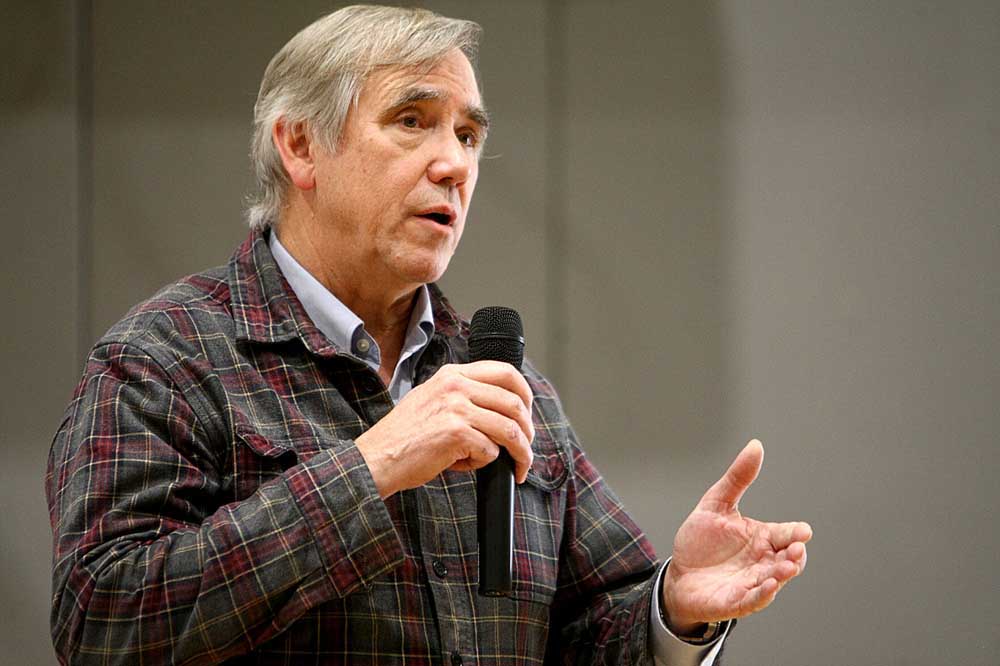Capital Chatter: ‘A major threat to Oregon values’
Published 8:00 am Thursday, November 2, 2017

- Capital Chatter: All sides waiting for Brown to lead
The Democratic Party of Oregon assailed businessman Sam Carpenter for entering the Republican race for governor. No surprise there. However, the party’s press release implied that a person could not be a Republican and still hold Oregon values.
That’s an affront to the state’s 706,896 Republican voters. Democrats have 971,195 voters, which means neither party has a majority of the 2,660,154 overall voters.
Trending
The release stated, “A number of Carpenter’s views are very much in line with the Republican primary electorate.”
Really? As if that were bad?
Maybe that was the Democrats’ underhanded way of encouraging Republicans to support Carpenter, instead of state Rep. Knute Buehler, who could be a more formidable candidate against Democratic Gov. Kate Brown.
• The governor listens: Gov. Brown visited South Eugene High School on Wednesday for what her staff billed as an opportunity “to meet with students participating in Career Technical Education (CTE) classes and to hold a listening session with students, teachers and invited businesses about the importance of CTE and how the state can best support these programs.”
Some politicians pontificate in such settings. Brown did not. She listened and asked in-depth questions of the students, staff and business. She visited the culinary program — whose students prepared a delicious, hearty lunch of Thai food — and a high-level computer class.
Those of us who cover politicians can become jaded because we’re constantly around them. We get used to them, we treat them as regular folks and we don’t always appreciate their impact when they visit people outside the State Capitol. But the dozens of people who talked with Brown on Wednesday had her ear, and they — especially the students — won’t forget that.
Trending
As for South Eugene’s CTE programs, they were impressive.
• Low-key ending to PERS task force: Wednesday’s trip was odd timing, because it also was the day that Gov. Brown’s PERS task force was releasing its multi-billion-dollar report.
Given the publicity put into her announcing creation of the task force earlier this year, I would have expected a follow-up press conference. To her credit, Brown did have an informal media availability with reporters at the conclusion of the South Eugene High visit, although I was the only one to ask about PERS.
• Richardson digs into Medicaid dollars: Democrats have criticized Republican Secretary of State Dennis Richardson for hyping and exaggerating the Oregon Health Authority’s Medicaid misspending. But he’s turned out to be right.
This week the public learned that the Oregon Health Authority — under previous management — erroneously paid roughly $74 million to health-care organizations during 2014-16.
In a press release responding to that news, Richardson foreshadowed what is coming next: “The Secretary of State’s Improper Medicaid Payments Audit report is scheduled to be released in the coming weeks. The thorough findings will reveal the mismanagement and waste of substantial amounts of taxpayer money. Stay tuned for that report.”
• Life in political PR: Jonathan Lockwood, who worked for the state Senate Republican caucus, has officially joined Knute Buehler‘s campaign as communications director. It’s a very interesting choice. Lockwood’s sharp-tongued press releases should play well with Republicans during the party primary. But his style could be problematic for a general-election campaign if Buehler then strives to present himself as “post-partisan.”
Aaron Fiedler, the new communications director for the state House Democratic caucus, did himself no favor by getting into a snit with a newspaper reporter.
The reporter broke the news about a letter — speaking out against sexual harassment — being circulated among women in the State Capitol. Fiedler had wanted the letter to be embargoed until legislators officially released it; however, a source gave the reporter an early draft. That’s good reporting. In what certainly doesn’t seem like an “Oregon value,” Fiedler responded by canceling the reporter’s interview that was about to take place with House Speaker Tina Kotek and Majority Leader Jennifer Williamson.
Natalie King, who worked in communications for Secretary of State John Kerry during the Barack Obama presidency, has joined Gov. Brown’s communication team to handle social media.
• Maybe it’s the water: Oregonians living in the Columbia River Gorge and inland are losing two well-respected Republican legislators. John Huffman of The Dalles resigned Saturday. He has been seeking an appointment from the Trump administration to serve with the U.S. Department of Agriculture in Oregon. County commissioners from Deschutes, Jefferson, Wasco and Wheeler counties will appoint his successor, who must be a Republican.
Mark Johnson of Hood River is the new president and CEO of Oregon Business & Industry, the business group created by this year’s merger of the longtime Associated Oregon Industries and the newer, more centrist Oregon Business Association. Oregon politicians long have complained that the state’s business community fails to speak with one voice, making it less influential at the Capitol. Johnson plans to resign his legislative seat Monday. His successor, who also must be a Republican, will be chosen by the commissioners from Hood River, Clackamas and Multnomah counties.
• More bureaucratic or more effective? The Northwest Power Planning and Conservation Council apparently didn’t appreciate this comment I made in last week’s Capital Chatter: “The Northwest council meets regularly and issues reports, but I’ve never been clear on whether it accomplishes anything meaningful.”
The council’s information officer sent this response:
“Congress authorized the four Northwest states to form the Council in the Northwest Power Act of 1980. The Act followed this region’s disastrous experiment in the 1970s with building five nuclear power plants, an effort that led to, among other things, rate increases of nearly 500 percent over several years for customers of the Bonneville Power Administration (including Salem Electric, for example) and the largest municipal bond default in U.S. history to that point. The Act took long-range power planning away from Bonneville and gave it to the states through the Council.
“The Act directed the Council to prepare a Northwest Power Plan and revise it every five years. Bonneville is required to implement the plan, which gives highest priority for meeting future demand for power to low-cost energy efficiency/conservation. As a result of the Council’s power plans, the Northwest has reduced demand for electricity by nearly 6,000 average megawatts (the power-demand equivalent of nearly six Seattles) since 1982 when the first plan was approved by the Council. Over time, this conservation has saved consumers billions of dollars every year — more than $4 billion in 2016 — from avoided costs to build power plants that would have been needed if the conservation had not been achieved. The conservation also means that carbon emissions are not emitted that would have been if new power plants, rather than conservation, had been built — this would have been more than 20 million tons in 2016.
“The Power Act also directed the Council to create a program as part of the power plan to protect and enhance fish and wildlife affected by hydropower dams in the Columbia River Basin. This mitigation money, which Bonneville provides, flows to the four states, Indian tribes, and others, primarily for habitat work and tribal-run hatcheries. The Council recommends projects to Bonneville for funding to implement the program after they are vetted through, and approved by, a panel of 11 independent scientists recommended to us by the National Academy of Sciences.
“In Fiscal Year 2016, the Oregon Department of Fish and Wildlife, tribes and others in the state (the Greenbelt Land Trust, for example) received a total of $93,022,212 for fish and wildlife mitigation projects through the Council’s program. Much of that was for work in Eastern Oregon. Several of our wildlife mitigation projects, which also help improve habitat for Willamette salmon, are in the Salem/Corvallis area. For 2016 Salem Electric reported energy savings of 1,649,276.03 kilowatt-hours (216,709 residential, 464,421 commercial, 967,790 industrial, and 354 low-income) for which Bonneville paid the utility $178,172.06, consistent with the Council’s power plan.”
Dick Hughes has been covering Oregon politics and state issues since 1976. Contact him at TheHughesisms@Gmail.com, Facebook.com/Hughesisms, YouTube.com/c/DickHughes or @DickHughes on Twitter.





